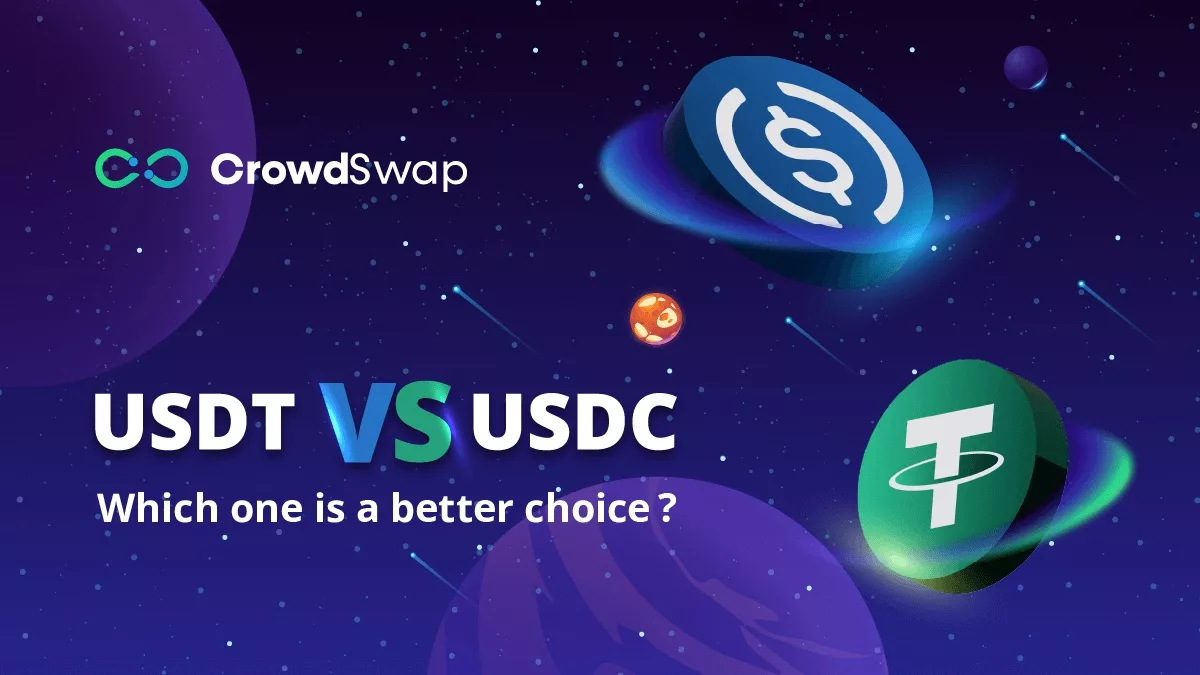Cryptocurrencies have seized the spotlight in an ever-evolving financial landscape, reshaping our notions of money and revolutionizing transactions. Given the increasing popularity of cryptocurrencies, this world has sought more stability, resulting in the proliferation of stablecoins. Some stablecoins are a type of cryptocurrency pegged to a valuable asset, such as gold, diamonds, silver, gemstones, or fiat currencies like the US Dollar and Euro. Therefore, unlike other cryptocurrencies, these coins will always have a fixed price. This article compares USDC vs. USDT and presents various topics to decide which is better for you.
What is stablecoin?
Stablecoin is a fixed-price cryptocurrency whose market value is usually attached to another stable asset. The value of one unit of a stablecoin is generally equivalent to one unit of a national currency or a specific asset. The most significant feature of stablecoins is their ability to maintain value against price fluctuations over time.
Stablecoins are sometimes used as a currency unit in e-commerce and are useful for everyday transactions and fund transfers between individuals and businesses.
The ongoing debate of USDC vs. USDT often arises, as these two stablecoins are the most well-known and popular stablecoins in the cryptocurrency market. They hold the first and second positions by market cap in the stablecoin market. However, are other stablecoins designed for specific blockchain platforms such as DAI, USDP, TUSD, and ….
What is USDC and USDT?
In 2018, the cryptocurrency exchange Coinbase and the company Circle collaborated to introduce their stablecoin called USD Coin (USDC) to the market. USDC is an ERC-20 standard token created on the Ethereum blockchain, backed one-to-one by the US Dollar. In essence, for every USDC in circulation, one US Dollar is held in a verified bank account.
This stablecoin was created to facilitate transactions on blockchain networks, providing a need for a reliable and transparent cryptocurrency in the world of cryptocurrencies. USDC complies with legal standards and has offered trust and transparency in the world of cryptocurrencies. While comparing USDC vs USDT, it’s evident that USDC aims to provide confidence and clarity in cryptocurrencies while adhering to legal standards.
USDT, or Tether, was founded in 2014 by a Hong Kong-based company called Tether Limited to bridge the gap between the world of cryptocurrencies and fiat currencies. For the first time in blockchain history, Tether introduced a cryptocurrency equivalent to the US Dollar that maintained many technical characteristics of cryptocurrencies like Bitcoin and Ethereum, but its price has no significant fluctuations. It quickly returns to its established value even if minor fluctuations occur.
USDC and USDT Use Cases:
• International Payments and Remittances:
USDC is a preferred and popular option for international payments and remittances due to its stability and compatibility with various blockchain platforms. USDC can be sent anywhere globally with minimal fees and high speed, regardless of the blockchain or network used.
Due to its low transaction costs and fast settlement times, USDT is utilized by users for sending funds globally. Tether’s stable value and blockchain compatibility make it an efficient choice for cross-border money transfers.
• Trading and Investment:
USDC and USDT act as a haven for traders and investors against the fluctuations of cryptocurrencies. Users can protect the value of their assets by swapping their volatile assets into USDC and USDT during market wild fluctuations.
Furthermore, investors can also preserve the value of their capital by converting their assets into USDC or USDT during periods of uncertainty. This capability safeguards their assets against significant market fluctuations and provides a convenient tool for promptly seizing investment opportunities available on financial platforms like CrowdSwap.
• DeFi (Decentralized Finance)
USDC and USDT play critical roles in the DeFi ecosystem as bridges between traditional financial assets and the decentralized financial world.
These two stablecoins have gained wide acceptance across various DeFi platforms, offering high liquidity. This liquidity allows users to trade and exchange these stablecoins with other cryptocurrencies or tokens on decentralized exchanges (DEXs). Additionally, stablecoins like USDC and USDT can be collateral for loans or yield farming in DeFi. Users can lock these assets as collateral to access additional funds and participate in various DeFi protocols.
Furthermore, stablecoins are used as trading pairs alongside other cryptocurrencies or tokens, enabling users to trade between these assets effectively. For example, the USDC/MATIC trading pair is available on platforms like CrowdSwap.
Read more: How to Invest in DeFi
Similarities of USDC and USDT:
• Stable value:
One of the key similarities between these two cryptocurrencies is that they are both stablecoins. This means that both of these stablecoins have an equivalent value, or at least relatively equivalent, to the US Dollar.
USDC and USDT maintain a stable value during cryptocurrency market turbulence and can be used as a reliable anchor.
• Financial Inclusion:
Both of these coins can enhance financial inclusion on a global scale. These coins are valuable for individuals who may not have access to traditional banking services, making digital financial services easily accessible to many.
USDC vs USDT:
• Adoption and Usage:
One notable distinction between USDC and USDT is their market entry timing. USDT entered the market approximately four years earlier than USDC, giving it a longer history of presence. Additionally, USDT boasts a higher trading volume compared to USDC.
• Transparency and Regulations:
When considering USDC vs. USDT, it’s evident that USDC stands out with its superior transparency and commitment to legal compliance. Regularly audit their reserves, and their operations follow a well-defined framework. This transparency is crucial for users who prioritize adherence to regulations.
On the other hand, Tether has faced concerns regarding transparency and has received warnings to be more transparent about its reserves.
USDC vs USDT: Which one is a better choice?
The choice between USDC and USDT depends on individual priorities. Both USDC and USDT have high liquidity and can be used for trading with other cryptocurrencies. They are widely accepted on most cryptocurrency exchanges and platforms.
-If you intend to participate in decentralized finance (DeFi) projects or have specific DeFi goals, choosing the appropriate stablecoin may depend on the projects. In many lending, staking, and liquidity provision projects, both USDT and USDC are accepted, and there might be a small difference between them, and their yield potential may vary.
-If regulatory compliance and transparency are top priorities, USDC would be preferred. It’s also suitable for individuals and institutions seeking a stable and trustworthy stablecoin.
-USDT is preferred for liquidity and investment in crypto with higher volume. Many exchanges and platforms support USDT, making it more accessible for trading.
Master Crypto with Confidence
CrowdSwap's decentralized exchange offers all the DeFi tools you need, with top-notch support at your fingertips
Conclusion:
When it comes to USDC vs. USDT, both stablecoins have their unique advantages and disadvantages. Your specific needs and risk tolerance will determine your preferred choice.
If you’re seeking high liquidity and greater trading activity, USDT could be the more suitable choice.
However, if transparency is of higher priority for you, you can opt for USDC.
Conducting thorough research and considering your priorities when deciding between USDC vs USDT for your crypto endeavors is essential.
FAQ:
USDC vs USDT: Which stablecoin is better for trading and investment?
Regarding trading and investment, USDC and USDT are commonly available on most cryptocurrency exchanges and serve as viable options. Your decision between the two often hinges on your personal preferences. If transparency and regulatory compliance are your top priorities, USDC might be the better fit. However, if you’re seeking high liquidity and greater trading activity, USDT could be the more suitable choice.
Can I use USDC or USDT for international payments and remittances?
Certainly, both USDC and USDT are well-suited for international payments and remittances. They provide reliability and quick transaction processing, making them convenient for transferring funds across borders. These stablecoins can be sent globally with minimal fees, irrespective of the blockchain or network you use.
Are there any risks associated with using USDC or USDT?
Although USDC and USDT are typically seen as stable and trustworthy, like all stablecoins, they do carry certain risks. These risks encompass potential regulatory alterations, the financial stability of the issuer, and the possibility of not having complete reserves backing. It’s crucial to conduct thorough research and thoughtfully weigh these aspects when using stablecoins.













